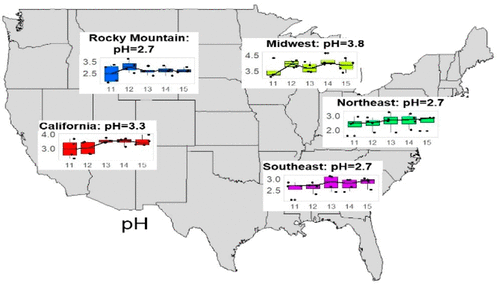Linked Response of Aerosol Acidity and Ammonia to SO2 and NOx Emissions Reductions in the United States
Linked Response of Aerosol Acidity and Ammonia to SO2 and NOx Emissions Reductions in the United States
- July 2018
- Peer-Reviewed Articles
- Mutiple
Lawal, A.S., Servadio, J.L., Davis, T., Ramaswami, A., Botchwey, N., & Russell, A.G. (2018). Linked Response of Aerosol Acidity and Ammonia to SO2 and NOx Emissions Reductions in the United States. Environmental Science & Technology, 52(17), 9861–9873.
ABSTRACT: Large reductions of sulfur and nitrogen oxide emissions in the United States have led to considerable improvements in air quality, though recent analyses in the Southeastern United States have shown little response of aerosol pH to these reductions. This study examines the effects of reduced emissions on the trend of aerosol acidity in fine particulate matter (PM2.5), at a nationwide scale, using ambient concentration data from three monitoring networks–the Ammonia Monitoring Network (AMoN), the Clean Air Status and Trends network (CASTNET) and the Southeastern Aerosol Research and Characterization Network (SEARCH), in conjunction with thermodynamic (ISORROPIA-II) and chemical transport (CMAQ) model results. Sulfate and ammonium experienced similar and significant decreases with little change in pH, neutralization ratio (f = [NH4+]/(2[SO42–] + [NO3–])), or nitrate. Oak Grove, MS was the only SEARCH site showing statistically significant pH changes in the Southeast region where small increases in pH (0.003–0.09 pH units/year) were observed. Of the five regions characterized using CASTNET/AMoN data, only California exhibited a statistically significant, albeit small pH increase of +0.04 pH units/year. Furthermore, statistically insignificant (α = 0.05) changes in ammonia were observed in response to emission and PM2.5 speciation changes. CMAQ simulation results had similar responses, showing steady ammonia levels and generally low pH, with little change from 2001 to 2011.





